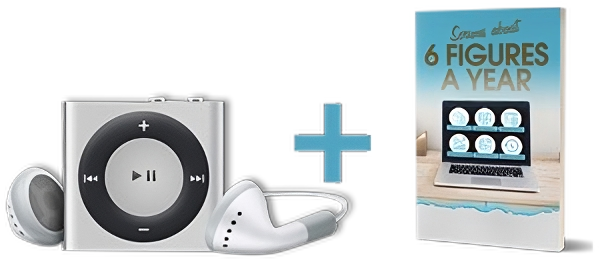9 Strategies to Your First Profitable Product
If you can find the RIGHT product, then the job of selling your product is half done. That’s because an in-demand product will do half of the selling for you.
On the other hand, the wrong product will mean you have to work ten times as hard to make a sale.
How do you come up with great product ideas? It’s tricky. It can feel like everything that can be sold is already BEING sold.
You look at the marketplace and there seems to be products for everything. But think of it this way… 5 years ago people thought the same thing. And yet, in the last 5 years, look at all the new products that have hit the market.
There is always a killer best-selling hot product that is just WAITING for you to find it, invent it or create it. You simply have to know where to look.
The key is to find a hungry market and then give that market what it wants. And it helps to understand the psychology of why people buy, too.
1: Solve a Customer’s Pain Point
Solving a customer’s pain point always has been and will be an effective strategy to develop a product people want.
Pain relievers like aspirin literally take away pain.
But more often than not, pain is a more abstract concept – the pain of stress, money problems, loneliness, low energy, out of shape, poor health, lousy job and so forth. All of these cause very real pain, and when you can relieve that pain, you make a sale.
Let’s say you’re at the dog park with your dog, and over and over again you hear dog owners lamenting the fact that dog toys are expensive and they don’t last. This is a pain point. You could solve this pain point by selling cheaper dog toys, selling dog toys that last longer, or even selling cheaper dog toys that last longer.
Pay special attention to when people say they are frustrated with a particular product or service. Notice when you find yourself thinking that something could be improved or something should be invented, if only somebody would do it. That somebody could be you.
2: Cater to Enthusiastic Hobbyists
The more passionate people are about their particular trade or hobby, the more money they’ll invest to get the exact product they want.
The classic example is golfers: They’re well-known for investing hundreds or even thousands of dollars to lower their score by a stroke or two.
I’ve personally seen collectors live on ramen soup for a month in order to afford their latest acquisition. And we’ve all seen online marketers buy yet another ‘how to’ course when they haven’t yet consumed the last dozen courses they already purchased.
Look for passionate people and you’ll have a hot market. Listen to what they say and watch what they do, and you’ll find product ideas worth pursuing.
Imagine you go through your day, observing people in their hobbies. You take a walk and you notice people out gardening. What can you offer them that helps them express themselves in their hobby, or makes their hobby even more fun?
Maybe you invent funny garden signs they can place amongst their plants, or t-shirts they can wear, or hats or even zany garden gloves that make them smile. Maybe you create an info product on 101 weird ways to grow the biggest, baddest, most glorious bug and disease free garden ever.
You see some people ride by on bicycles. They’d love some t-shirts that highlight their hobby, too. And how about outfitting their bikes to represent their personality and style? Not to mention an app that shows them all the best places in the area to bike, including elevation gains for hilly areas and cautions against dangerous streets for bikes.
Next, you walk by the gym, where you see people trudging through the door, carrying their duffle bags. They don’t look all that enthused to be there, do they?
Is it because they get tired of having to drive there, compete with others for space and equipment and shower in public? Maybe they’d rather work out at home, or even at a park or the beach. You could create a series of exercise videos that use nothing but their own bodyweight to get fit and trim in no time, with no gym membership and no equipment needed.
You get the idea. Keep your eyes open and watch for ideas because they are everywhere.
3: Your Personal Passion
This one is a little tricky. There is an old saying that if you do what you love, the money will follow.
Well, not necessarily. The key is that a lot of other people who are willing to spend money also need to share your passion.
But if you can use your know-how to create and position a unique product in a niche you love, it can be extremely profitable.
When you love your niche, the hard work of building a business, staying motivated and overcoming obstacles becomes a lot easier.
One blogger started writing about how to make money online. But she kept using her scuba experiences to illustrate points. The more scuba crept into her blog, the more she realized that her real passion was diving. Soon she started a diving website and is now making money promoting diving trips and selling diving equipment, as well as taking paid advertisements.
Another entrepreneur had a real passion for artwork. She could spend all day hunting art online and finding the best upcoming artists. She finally quit her accounting job and started her own website, where she highlights new artists, sells art products and beautiful accessories designed by her artists, and caters to people who love art with a passion. She also donates 10% of all proceeds to benefit nonprofits that are close to her heart.
4: Use Your Professional Experience
If you’re been working in a particular industry, odds are you know more about certain aspects of that industry than 99.9% of people on the planet.
Plus, you’ve likely made important contacts in the industry, learned certain skills and had your own unique set of experiences. Do you realize you’re more knowledgeable than the average person on these particular topics?
Then turning your expertise into your own online business might be a smart way to enter the market with a leg up that isn’t easy for others to duplicate or copy.
For example, a plumber might start an online business teaching people to do their own plumbing maintenance and fix small plumbing problems, as well as serving as a review site for local plumbers.
On the flip side, that same plumber can help new plumbers by teaching them the ins and outs of the business, as well as how to build up a large clientele fast, how to structure their business to limit liability, how to collect on slow paying customers, how to hire the right employees and be an effective boss and everything else related to a plumbing business.
5: Be an Early Adopter
Are you good at recognizing trends early enough to take full advantage of the opportunities? For example, maybe you spotted the opportunity with Bitcoin or cannabis before most people did.
Being first allows you to carve out a place in the market and establish yourself as a leader before others have a chance to.
Here’s the pitfall to watch out for when spotting trends – a trend is something long term with lots of potential. It should be profitable for at least a couple of years, and preferably a decade.
A fad, on the other hand, is generally here today and gone tomorrow. To capitalize on a fad you have to be super fast on your feet, and ready to pivot at a moment’s notice.
In the 70’s pet rocks were invented just for a kick. Each rock was nestled on a bed of straw inside a little box, with instructions on how to care for your new ‘pet.’ To everyone’s surprise, they sold like hotcakes. The problem occurred when others tried to copy the success of this product and couldn’t, because the pet rock was a fad, not a trend.
Of course, if you had started the pet rock fad yourself, you would have become a millionaire.
When you spot the right opportunity, act fast. It’s generally always the first movers who have an extreme advantage.
Here are a few ways to watch for what’s trending.
Social listening: Watch trending hashtags on Twitter or topics on Facebook. Use social listening tool software to identify and monitor trends over time.
Google Trends: Watch and monitor the popularity of topics over time, looking for upward trends that show no sign of tapering off.
Trend Hunter: https://www.trendhunter.com From the website – “Spark new ideas with the world’s #1 largest, most powerful trend platform. We unlock insights with a global network of 237,694 Hunters, billions of views, AI and a skilled team of Researchers and Futurists. Join 3,500,000+ on the cutting edge.”
Reddit: http://www.reddit.com This “Front page of the internet” showcases forums about nearly every topic under the sun – even cat toe beans. Visit the popular page to see what people are buzzing about.
6: Read Customer Reviews for Existing Products
There is a wealth of insight you can glean from customer reviews.
Do you already have a line of products? See what your customers are saying about them. Look for areas where your product fell short. Look for trends and interesting feedback that you can use as inspiration for your next product.
Next, go to Amazon and other sites to read feedback on products in your niche. What are their complaints? What do they love? How can you either improve on what’s out there, or completely reinvent something?
This works especially well for information products. Make a list of everything customers love and everything they complain about on your topic. Then use this as a starting point for your next creation.
7: Use Keyword Research to Find Product Opportunities
You might think this is doing things backwards, but by strategically looking for product ideas based on real search queries, you can gain valuable insight into what you can not only sell, but also get ranked high in the search engines.
Imagine you launch a product that Google immediately places on page one of the natural results – you’ll have free traffic for as long as Google is loving what you offer.
This approach is somewhat technical and takes a good understanding of keyword research and search engine optimization.
But by pairing product demand to existing keywords, you really can capture consistent organic traffic from Google. Of course, if Google changes its algorithm, that free traffic could disappear.
It’s important to remember that Google isn’t the only place where people start their search. Amazon, Ebay, Etsy, YouTube and other online marketplaces also have their own search functions, which means lots of keyword data as well.
Here are a few tools you can use to uncover popular search terms, which may help you find the next product to sell:
Keywords Everywhere https://keywordseverywhere.com/
Keyword Tool https://keywordtool.io/
Keyword Inspector https://www.keywordinspector.com/simple/index.php
Helium 10 https://www.helium10.com/
Sonar Keyword Tool (Amazon) http://sonar-tool.com/us/
Etsy Rank https://erank.com/
Alibaba Keyword Tool https://keywordkeg.com/alibaba-keyword-tool.html
8: Test Before You Launch
Here’s a nifty trick to find out ahead of time if there is going to be a market for your product.
Create a webpage that explains what’s so great about your product. It’s a sales page you put together without overthinking – sort of a “just get it done” type of page.
Send traffic to the page, either through your list and social media, or by paying for traffic.
You can approach this in different ways – take preorders and let customers know the product will be finished and delivered on a certain date.
Or explain the product and let them join a waiting list to be the first to purchase it.
The first option will give you a much better sense of how well the product will sell, since people are laying out their money for the product. But be sure you know exactly when the product will be ready.
If there is little or no interest in the product, and you’re fairly certain you targeted the right people, then count yourself lucky that you didn’t go through the hassle of creating the product just to find out it wouldn’t sell.
9: Always be on the Lookout
Above all else, just keep an open eye and an open mind.
Write down every idea you get, no matter how bad or good it is. This prompts your subconscious to find even more ideas.
Ideas can come at any moment, including in the middle of the night or the middle of a shower. Be prepared to write them down.
Then review your lists and see what you’ve got. Somewhere in there is a pot of gold just waiting for you.
Hopefully these ideas will get you on the road to lucrative product creation.
Claim Your Free MP3 And PDF Training: The 3-Part Plan To Topping $100,000 Per Year In Profit
Enter your name and email address below to receive a new lesson delivered to your inbox once a week. Your first lesson will be delivered immediately.

Privacy Policy : We value your privacy. You can unsubscribe from receiving future emails with 1 click at any time.

















